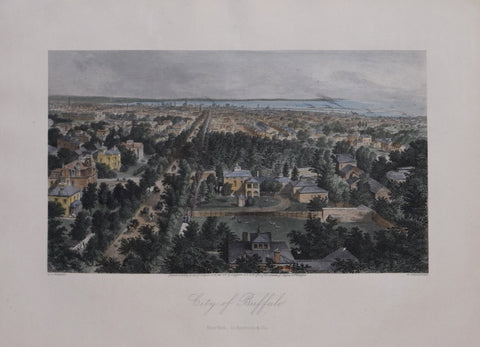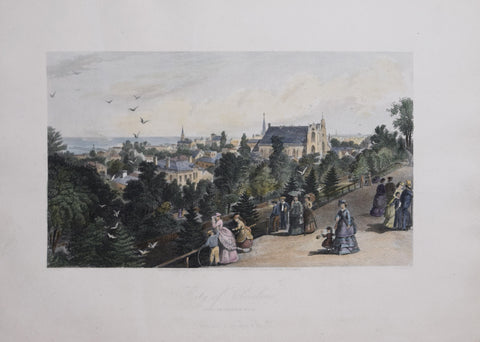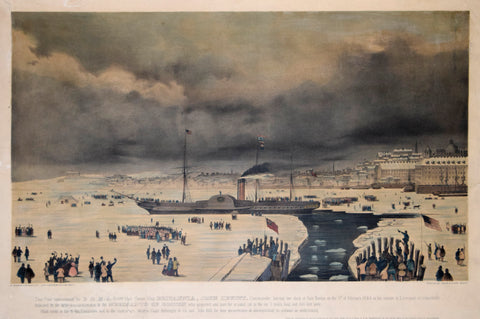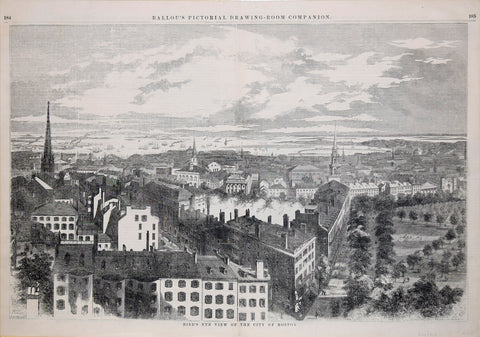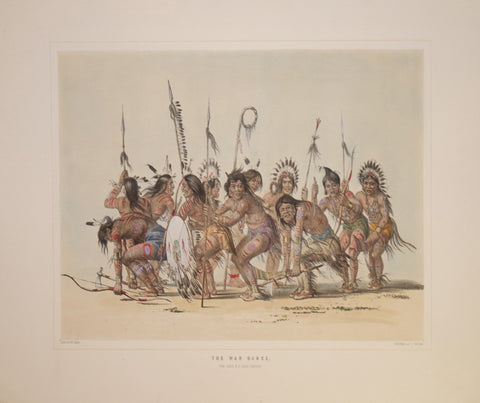
George Catlin (1796-1872), War Dance
George Catlin (1796-1872)
War Dance
From The North American Indian Portfolio
London, 1844
Lithographs with original hand-coloring
Sheet size: approx. 16 1/2 x 23"
George Catlin was the earliest great artist to travel extensively among the Plains Indians of North America and visually record their customs and artifacts. Through the important body of paintings and graphics he created and his carful written observations he sought to persuade his contemporaries that Native American culture should be honored and preserved.
In 1830 Catlin began his first journey up the Missouri River accompanying General William Clark on a diplomatic mission into Native American territory. His travel was inspired by his longstanding interest in Native American culture and by his observation of a delegation of Native Americans who were on their way to Washington, D.C. In doing so left behind earlier careers as a Philadelphia attorney and a portrait miniaturist. His goal was perhaps best expressed in the preface to the first edition of his North American Indian Portfolio: "The history and customs of such a people, preserved by pictorial illustrations, are themes worthy the lifetime of one man, and nothing short of the loss of my life shall prevent me from visiting their country and becoming their historian."
St. Louis became Catlin’s base of operations for five trips he took between 1830 and 1836, eventually visiting fifty tribes, the Pawnee, Omaha, Ponca, Mandan, Hidatsa, Cheyenne, Crow, Assiniboine, and Blackfeet among them. The artist’s hundreds of portraits, scenes, and landscapes and extensive collection of Indian artifacts he accumulated on his excursions became famous as Catlins “Indian Gallery", when it started touring the United States in 1837 and prior to its London debut two years later.
Having established a name for himself with the success of the “Indian Gallery”, Catlin focused his attention on finishing his first book, The Manners, Customs, and Condition of the North American Indians… which first appeared in the autumn of 1841. This book was to become one of the most important works on American Indians published in the 19th century. Catlin's project filled a great need. Following Lewis & Clark's celebrated expedition up the Missouri River into the Pacific Northwest, Europeans read avidly of the sights and experiences of the voyage. They traced the route followed by the explorers, using the map that accompanied the wildly popular printed volumes on the journey.
Lacking, however, from the accounts of the expedition of Lewis and Clark was pictorial documentation and its audience (both American and European) were unable to visualize the journey. This lacuna meant that the people, landscapes, and customs of the vast American frontier remained abstract ideas, much less vividly imaginable to anyone who had not personally experienced the voyage. When first issued in 1844, Catlin’s portfolio presented animated, colorful, sympathetic views of Native Americans finally filled the void of imagery.
Its arrival brought about the ability for Europeans and Americans to visualize the people and customs of whom they had read so extensively, and to gain a level of respect for the Native Americans, so often feared, misunderstood or misrepresented. The artist's stunning lithographs ranged from portraits to depictions of tribal ceremonies, from the anecdotal to the idealized. Catlin appealed to his readers with the thrill of the hunt and the mystery of ritual, and conveyed his respect for his subjects masterfully. The immediacy of his images is irresistible, drawing viewers into the scenes and portraits with unprecedented intimacy. But even when Catlin issued the North American Indian Portfolio, just fifteen years after his expedition, his crusade to preserve America's "Noble Savage" was failing. The Indians were beginning to give way to the expansion of the American frontier and to European disease. Because most of Catlin's paintings and collections were destroyed by fire or neglect, his lithographs remain the principal medium by which his message was conveyed, and they have come to hold even greater significance today than when they were first published.
We Also Recommend


